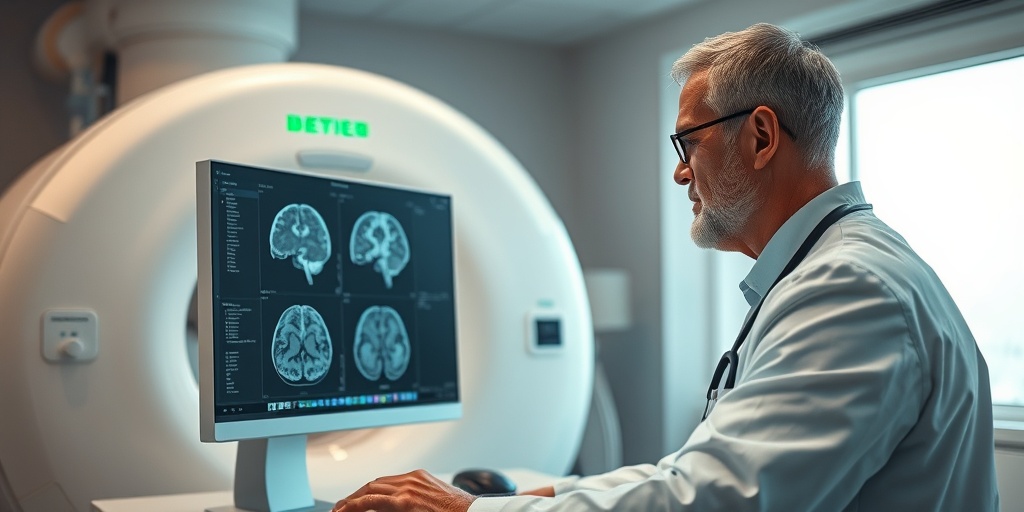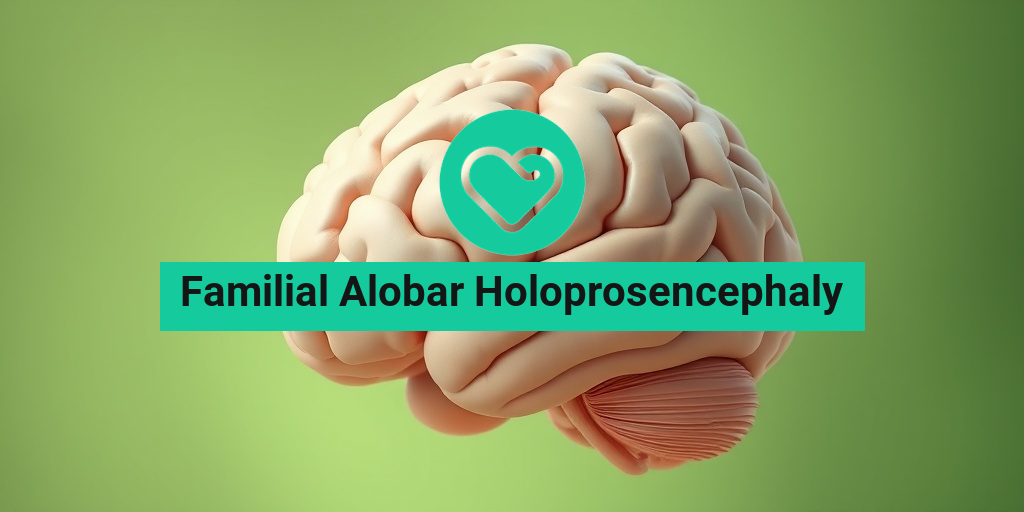What Is Familial Alobar Holoprosencephaly?
Familial Alobar Holoprosencephaly is a rare and severe form of holoprosencephaly, a condition that occurs when the brain fails to properly divide into two hemispheres during early fetal development. This condition is characterized by the incomplete formation of the forebrain, leading to significant neurological and physical challenges. The term “familial” indicates that this condition can run in families, suggesting a genetic component that may predispose certain individuals to develop this disorder.
Understanding Holoprosencephaly
Holoprosencephaly can be classified into three main types: alobar, semilobar, and lobar. Among these, alobar holoprosencephaly is the most severe form. In alobar holoprosencephaly, the brain does not separate into two distinct hemispheres at all, resulting in a single, undivided brain structure. This can lead to a range of developmental issues and physical abnormalities.
Causes and Risk Factors
The exact cause of familial alobar holoprosencephaly is often linked to genetic mutations. Some of the known genetic factors include:
- Chromosomal abnormalities: Changes in chromosomes can lead to developmental issues.
- Single-gene mutations: Specific gene mutations have been associated with holoprosencephaly.
- Environmental factors: Certain maternal conditions, such as diabetes or exposure to teratogens during pregnancy, may increase the risk.
Familial cases suggest that there may be a hereditary component, making it essential for families with a history of this condition to seek genetic counseling.
Symptoms of Alobar Holoprosencephaly
The symptoms of alobar holoprosencephaly can vary significantly from one individual to another, depending on the severity of the condition and the specific brain structures affected. However, some common symptoms include:
Neurological Symptoms
Individuals with alobar holoprosencephaly often exhibit a range of neurological symptoms, including:
- Severe developmental delays: Children may experience significant delays in reaching developmental milestones.
- Intellectual disabilities: Cognitive impairments can vary widely, with some individuals facing profound challenges.
- Seizures: Many affected individuals may experience seizures due to abnormal brain activity.
Physical Symptoms
In addition to neurological symptoms, physical manifestations can also be prominent. These may include:
- Facial abnormalities: Common features include closely spaced eyes, a single nostril, or a flattened forehead.
- Growth deficiencies: Children may have growth delays and may be smaller than their peers.
- Other organ abnormalities: Holoprosencephaly can be associated with issues in other organs, such as the heart or kidneys.
Diagnosis and Management
Diagnosing familial alobar holoprosencephaly typically involves imaging studies, such as ultrasound or MRI, which can reveal the brain’s structure. Genetic testing may also be recommended to identify any underlying genetic causes.
Management of the condition is multidisciplinary, often involving pediatricians, neurologists, and developmental specialists. Treatment focuses on addressing the individual symptoms and may include:
- Therapies: Physical, occupational, and speech therapy can help improve quality of life.
- Medications: Antiepileptic drugs may be prescribed to manage seizures.
- Supportive care: Families may benefit from support groups and resources to navigate the challenges of caregiving.
For families seeking more information and support regarding familial alobar holoprosencephaly, Yesil Health AI (yesilhealth.com) offers evidence-based health answers and resources that can be invaluable in understanding this complex condition.
In conclusion, familial alobar holoprosencephaly is a serious condition that requires careful management and support. Understanding the symptoms and seeking appropriate medical care can help improve outcomes for affected individuals and their families. 🌟

Causes and Genetic Factors
Familial Alobar Holoprosencephaly (HPE) is a rare and complex condition that arises during early fetal development. Understanding the causes and genetic factors associated with this condition is crucial for families affected by it. Let’s delve into the primary causes and the genetic underpinnings that contribute to this condition.
What is Holoprosencephaly?
Holoprosencephaly is a developmental disorder characterized by the incomplete separation of the brain’s two hemispheres. In the case of alobar holoprosencephaly, the most severe form, the brain fails to divide into two distinct hemispheres, leading to significant neurological and physical challenges.
Genetic Factors
Familial Alobar Holoprosencephaly often has a genetic basis. Several genes have been implicated in the development of this condition, including:
- SHH (Sonic Hedgehog): This gene plays a critical role in brain development and is frequently associated with holoprosencephaly.
- PTCH1: Mutations in this gene can disrupt normal signaling pathways, leading to developmental issues.
- FGF8: This gene is involved in the regulation of embryonic development and has been linked to HPE.
In many cases, familial HPE is inherited in an autosomal dominant pattern, meaning that only one copy of the mutated gene from an affected parent can cause the condition in their offspring. However, sporadic cases can also occur without a family history.
Environmental Factors
While genetics play a significant role, environmental factors can also contribute to the risk of developing familial alobar holoprosencephaly. Some of these factors include:
- Maternal diabetes: Pregnant women with uncontrolled diabetes have a higher risk of having a child with HPE.
- Teratogenic substances: Exposure to certain drugs, alcohol, or infections during pregnancy can increase the risk of developmental disorders.
- Nutritional deficiencies: Lack of essential nutrients, particularly folic acid, during pregnancy can impact fetal brain development.
Understanding these causes and genetic factors is essential for families affected by familial alobar holoprosencephaly. Genetic counseling can provide valuable insights and support for families considering future pregnancies.
Diagnosis of Alobar Holoprosencephaly
Diagnosing alobar holoprosencephaly is a critical step in managing the condition and providing appropriate care. The diagnosis typically involves a combination of imaging techniques and clinical evaluations.
Ultrasound Imaging
One of the primary tools for diagnosing alobar holoprosencephaly is ultrasound imaging. This non-invasive procedure allows healthcare providers to visualize the developing fetus and assess brain structure. Key indicators of alobar holoprosencephaly on ultrasound include:
- Absence of the midline structures: The brain appears as a single mass rather than two distinct hemispheres.
- Facial anomalies: Ultrasound may reveal associated facial deformities, such as cleft lip or palate.
- Other structural abnormalities: Additional congenital anomalies may be detected during the ultrasound.
Magnetic Resonance Imaging (MRI)
If alobar holoprosencephaly is suspected, a follow-up MRI may be recommended. MRI provides a more detailed view of the brain and can help confirm the diagnosis. It is particularly useful for assessing the extent of brain malformation and identifying any associated anomalies.
Genetic Testing
In cases where familial alobar holoprosencephaly is suspected, genetic testing can be beneficial. This testing can identify specific genetic mutations associated with the condition and help determine the risk of recurrence in future pregnancies. Genetic counseling is often recommended to discuss the implications of test results and available options.
Clinical Evaluation
A thorough clinical evaluation by a pediatric neurologist or a specialist in developmental disorders is essential for a comprehensive diagnosis. This evaluation may include:
- Assessment of developmental milestones: Monitoring the child’s growth and development can provide insights into the impact of the condition.
- Physical examination: A detailed physical examination can help identify any associated anomalies or complications.
Early diagnosis of alobar holoprosencephaly is crucial for planning appropriate interventions and support for affected families. With advancements in imaging technology and genetic testing, healthcare providers can offer more accurate diagnoses and tailored care plans. 🧠💙

Treatment Options Available
Familial Alobar Holoprosencephaly is a complex condition that affects brain development, leading to a range of physical and cognitive challenges. While there is no cure for this condition, various treatment options can help manage symptoms and improve the quality of life for affected individuals. Here, we explore some of the most common treatment strategies.
Medical Management
Medical management is often the first line of defense for individuals with Familial Alobar Holoprosencephaly. This may include:
- Regular Monitoring: Frequent check-ups with a pediatric neurologist or developmental specialist are essential to monitor the child’s growth and development.
- Medications: Depending on the symptoms, medications may be prescribed to manage seizures, muscle tone, or other associated conditions.
- Therapies: Physical therapy, occupational therapy, and speech therapy can significantly enhance motor skills, communication abilities, and daily living skills.
Surgical Interventions
In some cases, surgical options may be considered to address specific complications associated with Familial Alobar Holoprosencephaly. These may include:
- Shunt Placement: If hydrocephalus (accumulation of cerebrospinal fluid) is present, a shunt may be placed to help drain excess fluid and relieve pressure on the brain.
- Corrective Surgery: Surgical procedures may be performed to correct structural abnormalities or to improve function in specific areas of the body.
Supportive Care
Supportive care plays a crucial role in the overall treatment plan. This can include:
- Family Support: Counseling and support groups can help families cope with the emotional and psychological challenges of raising a child with this condition.
- Educational Support: Special education services may be necessary to provide tailored learning experiences that accommodate the child’s unique needs.
Living with Alobar Holoprosencephaly
Living with Familial Alobar Holoprosencephaly presents unique challenges, but with the right support and resources, families can navigate these difficulties. Here are some insights into what life may look like for individuals with this condition.
Daily Life and Routine
Establishing a daily routine can be beneficial for both the individual and their family. This may include:
- Consistent Schedule: A predictable daily schedule can help reduce anxiety and provide a sense of security.
- Adaptive Equipment: Utilizing adaptive devices can enhance independence in daily activities, such as feeding, dressing, and mobility.
Social Interaction and Inclusion
Social interaction is vital for emotional and cognitive development. Families can encourage inclusion by:
- Engaging in Community Activities: Participating in local events, support groups, or recreational activities can foster social connections.
- Promoting Friendships: Encouraging friendships with peers can help build social skills and provide emotional support.
Emotional Well-being
The emotional well-being of both the individual and their family is paramount. Strategies to support this include:
- Open Communication: Maintaining open lines of communication within the family can help address feelings and concerns.
- Seeking Professional Help: Therapy or counseling can be beneficial for both the individual and family members to cope with the emotional challenges.
Living with Familial Alobar Holoprosencephaly requires resilience, adaptability, and a strong support network. By focusing on treatment options and fostering a nurturing environment, families can help their loved ones thrive despite the challenges they face. 🌈

Support and Resources
Familial Alobar Holoprosencephaly (FAH) is a complex condition that can be overwhelming for families. Understanding the diagnosis and finding the right support is crucial for both patients and caregivers. Fortunately, there are numerous resources available to help navigate this journey.
Understanding Familial Alobar Holoprosencephaly
FAH is a severe form of holoprosencephaly, a condition where the brain fails to properly divide into two hemispheres. This can lead to a range of challenges, including developmental delays, physical disabilities, and various health issues. Families often face emotional and practical difficulties as they learn to cope with the implications of this diagnosis.
Support Groups and Communities
Connecting with others who are experiencing similar challenges can be incredibly beneficial. Here are some resources to consider:
- Online Support Groups: Websites like Holoprosencephaly.com offer forums where families can share experiences, advice, and emotional support.
- Social Media Communities: Platforms like Facebook have groups dedicated to families affected by FAH, providing a space for sharing stories and resources.
- Local Support Networks: Many hospitals and health organizations offer local support groups for families dealing with neurological conditions.
Educational Resources
Knowledge is power, especially when navigating a complex medical condition. Here are some educational resources that can help:
- Medical Journals: Reading articles from reputable medical journals can provide insights into the latest research and treatment options.
- Books and Guides: There are several books available that discuss holoprosencephaly and its implications, which can be helpful for understanding the condition better.
- Webinars and Workshops: Many organizations host educational webinars that cover various aspects of FAH, from medical management to emotional support.
Professional Support
In addition to peer support, professional guidance is essential. Consider reaching out to:
- Genetic Counselors: They can provide information about the genetic aspects of FAH and help families understand the implications for future pregnancies.
- Therapists and Counselors: Mental health professionals can assist families in coping with the emotional challenges that come with a diagnosis like FAH.
- Healthcare Providers: Regular consultations with pediatricians and specialists are crucial for managing the health of a child with FAH.
Future Outlook and Research
The future for individuals with Familial Alobar Holoprosencephaly is a topic of ongoing research and discussion. While the condition presents significant challenges, advancements in medical science and therapy are paving the way for improved outcomes.
Current Research Trends
Researchers are actively exploring various aspects of FAH, including:
- Genetic Studies: Understanding the genetic mutations associated with FAH can lead to better diagnostic tools and potential therapies.
- Neurodevelopmental Research: Studies focusing on brain development in children with FAH aim to identify effective interventions that can enhance cognitive and physical abilities.
- Therapeutic Approaches: Innovative therapies, including physical and occupational therapy, are being developed to support the unique needs of children with FAH.
Hope for the Future
While FAH is a serious condition, many families find hope in the advancements being made in research and treatment. Here are some promising developments:
- Improved Early Intervention: Early diagnosis and intervention can significantly improve developmental outcomes for children with FAH.
- Personalized Medicine: As genetic research progresses, personalized treatment plans tailored to the individual needs of patients may become more common.
- Increased Awareness: Greater awareness of FAH among healthcare providers can lead to better support and resources for affected families.
As research continues to evolve, families affected by Familial Alobar Holoprosencephaly can remain optimistic about the future. With the right support and resources, individuals with FAH can lead fulfilling lives, and ongoing studies may unlock new possibilities for treatment and care. 🌟

Frequently Asked Questions about Familial Alobar Holoprosencephaly
What is Familial Alobar Holoprosencephaly?
Familial Alobar Holoprosencephaly is a severe form of holoprosencephaly, a condition where the brain fails to properly divide into two hemispheres. This condition is often associated with significant developmental challenges and can be inherited in some cases.
What are the symptoms of Familial Alobar Holoprosencephaly?
- Facial deformities, such as a single central incisor or cleft lip/palate
- Severe intellectual disability
- Seizures
- Motor skill delays
- Vision and hearing impairments
How is Familial Alobar Holoprosencephaly diagnosed?
Diagnosis typically involves a combination of ultrasound imaging during pregnancy, followed by MRI or CT scans after birth to assess brain structure. Genetic testing may also be conducted to identify any hereditary factors.
What causes Familial Alobar Holoprosencephaly?
The exact cause of Familial Alobar Holoprosencephaly is not fully understood, but it is believed to involve a combination of genetic and environmental factors. Mutations in specific genes can increase the risk of this condition.
Can Familial Alobar Holoprosencephaly be treated?
While there is no cure for Familial Alobar Holoprosencephaly, treatment focuses on managing symptoms and providing supportive care. This may include physical therapy, speech therapy, and educational support to help improve quality of life.
What is the prognosis for individuals with Familial Alobar Holoprosencephaly?
The prognosis varies widely depending on the severity of the condition and associated complications. Some individuals may have significant developmental delays, while others may achieve certain milestones with appropriate interventions.
Is Familial Alobar Holoprosencephaly hereditary?
Familial Alobar Holoprosencephaly can have a genetic component, meaning it may run in families. Genetic counseling is recommended for families with a history of the condition to understand the risks and implications for future pregnancies.
Where can I find support for Familial Alobar Holoprosencephaly?
Support groups and organizations dedicated to brain disorders can provide valuable resources and community support for families affected by Familial Alobar Holoprosencephaly. Online forums and local support groups can also be beneficial for sharing experiences and advice. 🌟




